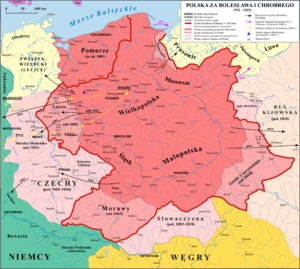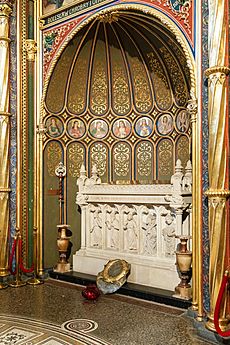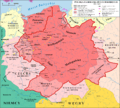Bolesław I the Brave facts for kids
Quick facts for kids Bolesław I the Brave |
|
|---|---|
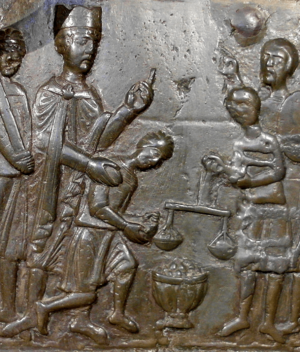
Bolesław I buys the corpse of Saint Adalbert for its weight in gold, Gniezno Doors, c. 1170
|
|
| Duke of Poland | |
| Reign | 992–1025 |
| Predecessor | Mieszko I |
| Duke of Bohemia | |
| Reign | 1003–1004 |
| Predecessor | Boleslaus III |
| Successor | Jaromír |
| King of Poland | |
| Reign | 1025 |
| Successor | Mieszko II Lambert |
| Born | c. 967 |
| Died | 17 June 1025 (aged 57–58) |
| Burial | Cathedral Basilica of Sts. Peter and Paul, Poznań |
| Wives |
|
| Issue Detail |
Bezprym Regelinda Mieszko II Lambert Otto |
| Dynasty | Piast |
| Father | Mieszko I of Poland |
| Mother | Dobrawa of Bohemia |
| Religion | Chalcedonian Christianity |
Bolesław I the Brave (born around 967, died June 17, 1025) was a very important ruler in Polish history. He was the Duke of Poland from 992 to 1025. In 1025, he became the first ever King of Poland. For a short time, from 1003 to 1004, he was also the Duke of Bohemia.
Bolesław was a member of the old Piast dynasty. He was a strong and smart leader who played a big role in Central Europe. He helped spread Western Christianity among his people. He also raised Poland to the level of a kingdom, making it a powerful state. This meant he was the first Polish ruler to be called rex, which is Latin for king.
Bolesław was the son of Mieszko I of Poland and his first wife, Dobrawa of Bohemia. He took control of Lesser Poland even before his father died. When Poland was divided in 992, he quickly reunited the country. He removed his father's last wife, Oda, and her sons.
As a strong Christian, Bolesław supported missionaries like Adalbert of Prague and Bruno of Querfurt. When Adalbert was killed in 997, Bolesław paid a huge amount of gold to get his body back. This act helped Poland become more independent from the Holy Roman Empire.
At the Congress of Gniezno in 1000, Emperor Otto III allowed Poland to have its own church system. This new system had a main church leader (Metropolitan See) in Gniezno. This church was independent from other powerful churches. New bishoprics (church areas) were also set up in Kraków, Wrocław, and Kołobrzeg. Bolesław also stopped paying tribute to the Empire.
After Emperor Otto III died in 1002, Bolesław fought several wars against Otto's cousin, Henry II. These wars ended with the Peace of Bautzen in 1018. In 1018, Bolesław captured Kiev and put his son-in-law, Sviatopolk I, in charge there. A famous story says Bolesław chipped his sword on Kiev's Golden Gate. This sword, called Szczerbiec (Jagged Sword), later became the special sword used to crown Polish kings.
Bolesław is seen as one of Poland's greatest Piast rulers. He was a skilled strategist and statesman. He made Poland as strong as older kingdoms in Western Europe. He led successful military campaigns to the west, south, and east. He conquered lands in what is now Slovakia, Moravia, Red Ruthenia, Meissen, Lusatia, and Bohemia. He also created new laws and built churches, monasteries, and forts. He even introduced Poland's first money system, the grzywna, and minted his own coins.
Contents
Early Life of Bolesław
Bolesław was born in 966 or 967. He was the first child of Mieszko I of Poland and his wife, Princess Dobrawa of Bohemia. An old text from the 11th century says Bolesław was born before his father became a Christian. Bolesław was baptized soon after his birth.
He was named after his grandfather, Boleslaus I, Duke of Bohemia. We don't know much about his childhood. An old record says he had a traditional hair-cutting ceremony at age seven. A piece of his hair was sent to Rome. This might mean his father wanted the Pope's protection for his son. Some historians think Bolesław was sent to the court of Emperor Otto I the Great as a sign of loyalty. However, this idea is debated by others.
Bolesław's mother, Dobrawa, died in 977. His father then married Oda of Haldensleben. Around this time, Bolesław became the ruler of Lesser Poland. It's not fully clear how this happened. Some say his father gave it to him. Others believe he took it with the help of local lords.
Becoming a Ruler
Mieszko I, Bolesław's father, died on May 25, 992. Records say Mieszko wanted to divide his kingdom among his sons. But Bolesław was very clever. He united the country and sent away his stepmother and half-brothers. Two Polish lords who supported them were blinded on Bolesław's orders. Some historians believe Bolesław took control of all Poland by 992. Others say it happened later, in 995.
Bolesław's first coins were made around 995. One coin had the name Vencievlavus. This shows he saw Duke Wenceslaus I of Bohemia as Poland's patron saint. In 992, Bolesław sent soldiers to help the Holy Roman Empire fight against the Polabian Slavs. In 995, he personally led a Polish army to help the emperor's troops. During this time, he met the young German ruler, Otto III.
Soběslav, a Bohemian leader, also joined the 995 campaign. While he was away, his family was attacked in Bohemia. Soběslav then found safety in Poland. Bolesław also welcomed Bishop Adalbert of Prague to Poland in 996. Adalbert and Bolesław worked closely together. In 997, Adalbert went to spread Christianity among the Prussians. But the pagans killed him on April 23, 997. Bolesław paid a large amount of gold to get Adalbert's body back. He buried it in Gniezno. He also sent parts of the body to Emperor Otto III, who was Adalbert's friend.
The Congress of Gniezno
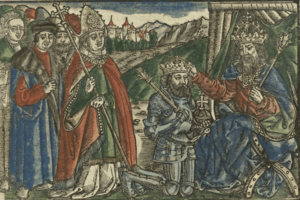
Emperor Otto III held a church meeting in Rome in 999. There, Adalbert was made a saint. Before December 999, Adalbert's brother, Radim Gaudentius, became "Saint Adalbert's archbishop." Emperor Otto III then made a pilgrimage to Saint Adalbert's tomb in Gniezno in early 1000. He was joined by a special representative from the Pope.
Historians wrote about how grandly Bolesław welcomed the emperor. One writer, Gallus Anonymus, said Bolesław showed off his knights and princes. They were lined up in colorful clothes made of the finest materials.
Bolesław used the emperor's visit to his advantage. After the visit, Poland began to become a truly independent state. This was different from Bohemia, which remained under German control. Some people criticized Otto III for treating Bolesław as an equal. Gallus Anonymus said Otto III called Bolesław "his brother and partner" in the Holy Roman Empire. He also called Bolesław "a friend and ally of the Roman people." The chronicler also wrote that Otto III put his own crown on Bolesław's head. Bolesław also received a piece of the True Cross and the Holy Lance.

These actions showed that Bolesław gained royal powers, including control over the Church in Poland. Radim Gaudentius became the archbishop of the new Roman Catholic Archdiocese of Gniezno. Three other bishoprics were set up under Gniezno: Kołobrzeg, Kraków, and Wrocław. Bolesław promised to pay Peter's Pence to the Pope. This helped get the Pope's approval for the new archdiocese.
During the emperor's visit, Bolesław also showed off his wealth. He gave Otto III many gold and silver dishes and fine textiles. He also gave the emperor a group of "three hundred armored warriors." Bolesław also gave Saint Adalbert's arm to the emperor.
After the meeting, Bolesław went with Otto III to Magdeburg in Germany. They celebrated Palm Sunday there in 1000. Some records say Bolesław also went with Otto to Aachen. There, Otto III opened Charlemagne's tomb and gave Charlemagne's golden throne to Bolesław.
Coins made for Bolesław after this meeting had "Gnezdun Civitas" on them. This showed he saw Gniezno as his capital. The coins also mentioned "Princes Polonie," referring to the Polish princes. Emperor Otto III died young in 1002. Many historians say Bolesław was very sad about his death.
In 1000, Bolesław also made a law against hunting beavers. He created a special job called "Bobrowniczy" to make sure this law was followed.
Expanding Poland's Borders
After Otto III died, three people wanted to become the new German king. One of them, Duke Henry IV of Bavaria, promised Bolesław land if he helped him. But another strong contender was killed. Henry of Bavaria became king.
Bolesław was worried that King Henry would not be friendly to Poland. So, he took advantage of the situation and invaded Lusatia and Meissen. He captured land up to the Elbe River, including Bautzen and Strehla. In July 1002, Bolesław met with German lords. King Henry only confirmed Bolesław's control of Lusatia. He gave Meissen to someone else.
Later, assassins tried to kill Bolesław in Merseburg. Bolesław blamed the king. In return, he attacked and burned Strehla, taking its people captive.
In 1002, Duke Boleslaus III of Bohemia was removed from power. Bohemian lords made Vladivoj their new duke. Vladivoj had fled to Poland earlier. Some historians think Bolesław helped Vladivoj become duke. After Vladivoj died in 1003, Bolesław invaded Bohemia. He put Boleslaus III back in charge, but Boleslaus III had many Bohemian nobles killed. The surviving nobles asked Bolesław to save them. Bolesław invaded Bohemia again and had Boleslaus III blinded. He entered Prague in March 1003. The Bohemian lords made him duke.
King Henry asked Bolesław to swear loyalty and pay tribute. But Bolesław refused. He also made friends with the king's enemies. King Henry then defeated one of Bolesław's allies. Bolesław also invaded Meissen, but couldn't capture its capital. It's also likely that Polish forces took control of Moravia and parts of northern Hungary (now Slovakia) in 1003. These areas stayed part of Poland until 1018.
King Henry allied with the pagan Lutici and attacked Lusatia in 1004. But heavy snow forced him to retreat. He invaded Bohemia again in August 1004. He brought Jaromír, the older brother of the blinded Boleslaus III. The Bohemians rebelled and killed Polish soldiers. Bolesław left Prague without a fight. King Henry made Jaromír the duke of Bohemia.
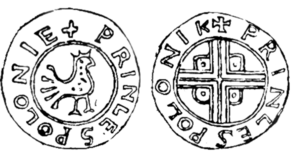
In 1005, King Henry's army reached Poznań in Poland. A peace treaty was signed there. Bolesław lost Lusatia and Meissen. He also likely gave up his claim to the Bohemian throne. Also in 1005, a pagan uprising in Pomerania ended Bolesław's rule there. A new church area was destroyed.
In 1007, King Henry ended the peace treaty. Bolesław had been trying to make allies among German nobles. He also gave shelter to the removed Duke of Bohemia. Bolesław then attacked the Archbishopric of Magdeburg and took back Lusatia. Germany fought back in 1010, but it wasn't very effective. In 1012, Bolesław invaded Lusatia again. His forces burned the city of Lubusz.
In 1013, a peace agreement was signed at Merseburg. Bolesław agreed to be loyal to King Henry for Lusatia and Sorbian Meissen. These lands were given to him as fiefs (lands held in return for loyalty). Bolesław's son, Mieszko II Lambert, married Richeza of Lotharingia. She was the granddaughter of Emperor Otto II. This marriage strengthened ties with German nobles. During this short peace, Bolesław also campaigned in the east, towards Kievan Rus'.
In 1014, Bolesław sent his son Mieszko to Bohemia to make an alliance against Henry. But Mieszko was captured and given to Henry. Henry released him after pressure from German nobles. Bolesław still refused to help the emperor in his Italian war. So, in 1015, war broke out again. The war started well for the emperor. But Bolesław's forces attacked elsewhere. The emperor's army retreated from Poland.
Later, Bolesław's forces took the lead. A German margrave was killed in a fight with Polish forces in 1015. In 1015 and 1017, Bolesław attacked the Eastern March (a border area). He was defeated twice.
Later in 1017, Bolesław's son Mieszko tried to capture Meissen, but failed. In 1017, Bolesław defeated Duke Henry V of Bavaria. That same year, Emperor Henry invaded Poland again. He tried to capture Głogów and Niemcza, but failed. His army had to retreat with heavy losses. Bolesław used this chance. He ordered his son to invade Bohemia, where Mieszko faced little resistance.
On January 30, 1018, the Peace of Bautzen was signed. Bolesław kept Lusatia and Sorbian Meissen as part of Poland, not as fiefs. He also got military help for his expedition against Kievan Rus'. Bolesław, who was a widower, also married Oda of Meissen. She was the daughter of a German margrave. The wedding happened on February 3, 1018.
War in Kiev
Bolesław first went east to support his son-in-law, Sviatopolk I of Kiev, in 1013. But the main battles happened in 1018, after the Peace of Bautzen. Sviatopolk I asked Bolesław for help. Bolesław led an army of 2,000–5,000 Polish warriors. He also had 1,000 Pechenegs, 300 German knights, and 500 Hungarian soldiers.
In July, Bolesław led his troops to the border. On July 23, he defeated the forces of Yaroslav the Wise, Prince of Kiev, at the Battle of the River Bug. All historical records agree that Bolesław won. Yaroslav retreated, leaving the way open to Kiev. The city had suffered from fires. It surrendered when the Polish army arrived on August 14. Bolesław's army was welcomed by the local archbishop.
A popular story says Bolesław chipped his sword (Szczerbiec) when he hit the Golden Gate of Kiev. Even though Sviatopolk lost the throne later, Poland gained back the Red Strongholds (later called Red Ruthenia) during this campaign. Bolesław's father had lost these lands in 981.
Becoming King and His Death
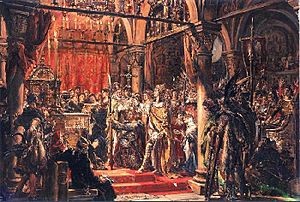
Historians disagree on the exact date Bolesław was crowned king. Most scholars believe it was in 1025. Some think it might have been as early as 1000. An old record says the crowning happened when Otto III gave Bolesław royal symbols at the Congress of Gniezno. However, German sources confirm that after Henry II died in 1024, Bolesław used the time when Germany had no emperor to crown himself king in 1025.
It is generally thought the coronation took place on Easter Sunday. Some believe it was on December 24, 1024, because coronations often happened during religious holidays. The exact place of the coronation is also debated. The cathedrals in Gniezno or Poznań are the most likely spots. After this, Poland became a kingdom, even before its neighbor, Bohemia.
Many believe Bolesław needed permission from the new Pope, Pope John XIX, for his coronation. Pope John was known to be open to bribes. Rome also hoped for an alliance with Poland to defend against the Byzantine Emperor. Some historians suggest that the German Emperor Conrad II quietly agreed to the coronation. The Pope then confirmed it.
According to a Czech historian, Bolesław I died shortly after his coronation, on June 17, 1025. He was old for that time. The exact cause of his death is not known. Historians believe Bolesław was buried at the Archcathedral Basilica of St. Peter and St. Paul in Poznań.
In the 14th century, King Casimir III the Great ordered a new tomb for Bolesław's remains. The old tomb was damaged in a fire in 1772 and destroyed in 1790. Bolesław's remains were then moved to the cathedral's chapter house. Some bone fragments were later given to historians and placed in museums.
Today, Bolesław I's burial place is still at Poznań Cathedral, in the Golden Chapel. His epitaph (a text on his tomb) is known to historians. This epitaph is one of the first sources that gave him his famous nickname, "Brave" (Polish: Chrobry). Later, a chronicler named Gallus Anonymus also called him "Bolezlavus who was called Glorious or Brave."
Bolesław's Family
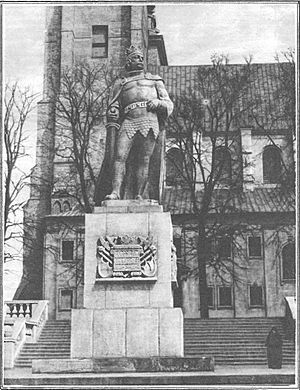
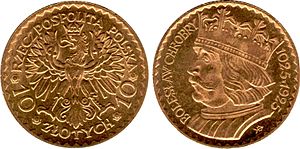
Historical records tell us about Bolesław's marriages and children.
Bolesław's first wife was a daughter of Rikdag, a German margrave. This marriage was likely arranged to strengthen ties with German lords. But Bolesław "later sent her away" after her father died in 985. The marriage no longer had political value.
Bolesław's second wife was a "Hungarian woman." Most historians think she was a daughter of the Hungarian ruler Géza. She gave birth to a son, Bezprym, but Bolesław also sent her away.
Bolesław's third wife was Emnilda. She was the daughter of a lord named Dobromir. He was likely a West Slavic prince. Their marriage happened around 988. Emnilda was said to have a good influence on Bolesław.
Bolesław and Emnilda had several children:
- Their oldest daughter (whose name is unknown) became an abbess (head of a convent).
- Their second daughter, Regelinda (born around 989), married Herman I, Margrave of Meissen in 1002 or 1003.
- Mieszko II Lambert (born around 990) was Bolesław's favorite son and later became king.
- Another daughter (name unknown, born 995) married Sviatopolk I of Kiev.
- Their youngest son, Otto, was born in 1000.
Bolesław's fourth marriage was to Oda of Meissen (born around 995), from 1018 until his death. She was the daughter of Margrave Eckard I of Meissen. They had one daughter, Matilda (born around 1018). She was engaged to Otto of Schweinfurt in 1035, but the marriage did not happen.
Images for kids
See also
 In Spanish: Boleslao I de Polonia para niños
In Spanish: Boleslao I de Polonia para niños
- Bolesław Chrobry Tournament – a speedway event named after the King
- Castle Chrobry in Szprotawa
- Crown of Bolesław I the Brave
- History of Poland (966–1385)



